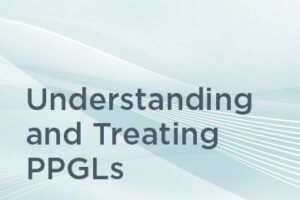By Anna Greene, PhD, NETRF Chief Scientific Officer
 NETRF-funded scientists uncover how oxygen levels shape tumor behavior and expose new treatment opportunities for pheochromocytomas and paragangliomas.
NETRF-funded scientists uncover how oxygen levels shape tumor behavior and expose new treatment opportunities for pheochromocytomas and paragangliomas.
Pheochromocytomas start in the adrenal glands, which sit on top of your kidneys. They grow from the cells that make “fight-or-flight” hormones like adrenaline. Paragangliomas begin in small nerve-related cell clusters found outside the adrenal glands. These clusters sit along nerves in the neck, chest, belly, and pelvis, including spots like the carotid body in the neck.
Understanding and treating pheochromocytomas and paragangliomas (PPGLs) has long been a challenge. These rare neuroendocrine cancers can behave unpredictably. While many are benign, some metastasize and resist available therapies. One reason progress has been slow is that researchers have lacked reliable lab models that truly mimic these complex human tumors.
A 2020 NETRF-funded study, led by Patricia Dahia, MD, PhD (UT Health San Antonio) and Alice Soragni, PhD (UCLA), has helped close that gap. In research posted as a bioRxiv preprint in August 2025, their teams created a diverse collection of patient-derived organoids (PDOs) from 35 PPGLs, representing a wide range of genetic drivers and clinical presentations. These miniature, three-dimensional tumor cultures faithfully retained the molecular and biochemical features of the patients’ tumors, offering a powerful new platform for discovery.
Oxygen: A Central Player in Tumor Behavior
Using this collection, the researchers found that oxygen levels profoundly affect how PPGL cells grow and evolve. Under low-oxygen (“hypoxic”) conditions, organoids were healthier and displayed a more “immature” cellular state, similar to early adrenal development. But when grown longer under normal oxygen levels, the tumor cells activated genes linked to HIF-2α, a master regulator of the body’s response to hypoxia, and began expressing features associated with more aggressive behavior.
This shift, the study shows, mirrors what happens in patients: over time, oxygen changes can push the tumors into a ‘low-oxygen mimic’ mode where cells become harder to treat—a pattern seen in high-risk PPGLs and even in treatment-resistant neuroblastomas, a related childhood cancer. These results highlight hypoxia as a key environmental driver of tumor plasticity and progression.
A New Way to Find Treatments
The team also performed the first broad drug screening in PPGL organoids, testing more than 50 approved and experimental therapies. The responses mirrored patterns seen in patients, validating the models’ clinical relevance. Among the findings, the CDK4/6 inhibitor abemaciclib, a drug already used for breast cancer, emerged as a promising new option for some PPGLs. The study also confirmed activity of belzutifan, a recently FDA-approved inhibitor of HIF-2α, in organoids carrying pseudohypoxic mutations.
Why This Matters
For patients and families affected by pheochromocytomas and paragangliomas, this research offers new hope. By recreating patient tumors in the lab, scientists can now probe how PPGLs adapt to their environment, test drugs more efficiently, and uncover biomarkers to predict which therapies may work best.
As NETRF continues to support innovative, patient-centered research platforms, studies like this bring us closer to personalized treatment strategies for these rare and often unpredictable neuroendocrine cancers.
Related article
